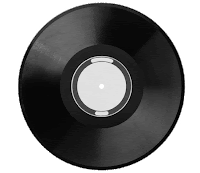1) It's an analog format. Because vinyl is an analog medium, a record has a theoretical frequency response that goes to the moon. Seriously though, it goes way beyond our what we consider our "text book" hearing limits. It's easy to get into a debate as to if that really matters or not. Some audio scientists will tell you that we can feel the harmonic detail beyond 20kHz and that adds to the realism, while others will point to a mountain of data that shows that theory is rubbish.
That said, it sure does sound better than a CD, doesn't it? A CD's upper frequency response is theoretically around limited to around 22kHz, thanks to the 44.1kHz CD sample rate and something called the Nyquist Frequency, which states that you can't have a frequency response that goes beyond 1/2 of the sample rate (otherwise, you get some nasty sonic digital artifacts). What actually happens in real life is that a filter is used to keep the frequency response below the Nyquist Frequency, and that filter introduces it's own set of artifacts. That's one of the reasons why some CD/DVD players are so expensive; they've got better filters.
What this all adds up to is there's something going on in the upper frequencies on vinyl that our ears seem to like. What that is can be debatable, but we do like it.
2) Was the master analog? Vinyl really helps the sound and feel of a digital master, especially one made at a higher sampling rate like 96 or 192kHz, but it really sounds great if the source was originally an analog magnetic tape master. It still sounds pretty good if the source is from a 44.1kHz CD master source, but not as good as a hi-res digital or analog master. Yes, it's better than a CD, but doesn't have nearly the depth and "air" that an analog master has. This is why we tend to like the vinyl reissues of classic albums so much.
3) Vinyl is subject to sonic degradation. The big downside to vinyl is that from the first play onward, a vinyl record sonically degrades. Think about it. You have this diamond stylus (you know, the hardest natural substance known to man) that's constantly grinding up against the soft plastic grooves and wearing them down. After the first 10 plays or so, you're never going to hear it that good again. After about 20, you'll be hearing a lot of more of the noise floor, clicks and pops, although it will happen so gradually that you'll get used to them by then. Still, like magnetic tape losing oxide from the friction across the tape head. Your first pass is always the best.
Those are just a few things to think about when it comes to vinyl. Now get out to your record store and buy some!
If you want to know more about the vinyl record and how it's made, there are some great microscope shots of different record grooves in The Mastering Engineer's Handbook.
----------------------------------
Help support this blog. Any purchases made through our Amazon links help support this website with no cost to you.You should follow me on Twitter for daily news and updates on production and the music business.
Don't forget to check out my Music 3.0 blog for tips and tricks on navigating social media and the new music business.



6 comments:
Vinyl is reproducing usable information above 20k on mid-priced turntables? Stereo speakers and receivers are reproducing frequencies over 20k? I'm not sure that's the answer. If so then 96/24 digital would be as good or better than vinyl, and I don't hear people saying that. I think it's something else.
If you have the same engineer with the same equipment working on the same material, you'll get different results.
This means stuff mastered by different people with different equipment expands the chances for different products.
There are other similar variables in the consumer's side as well, such as the room / player / speaker / environment.
My guess is people, specially the so-called audiophiles, get addicted to the whole system. All sound properties are attached to their perception, memories and feelings.
It's not one better than the other, just different.
Yes, I sure did exaggerate a little on this one without an explanation. It's true that most of your signal path, especially your speakers, can't reproduce beyond 20kHz. But there's a lot of evidence that suggests that those upper harmonics add something to the music nonetheless. That's certainly not the only reason why our ears like vinyl, but it's a big one.
Aren't the frequency filters applied before the mastering of the CD? Why would a player need filters if the frequencies are already gone?
Without getting into a long technical discussion, there's a filter on the D/A side that that is responsible for reshaping the analog waveform. That's one of the more critical ones in the signal path.
May I suggest you to watch this video, kind of funny but in the other hand shows how far some people go in order to achieve the best posible sound when it comes to vinyl listening. Most of the times when you get in touch with people who loves to listen to vinyls, you probably end talking with people like this. Esoteric or true, hope you enjoy!
http://www.youtube.com/watch?v=xs1aUws0Lrs
Post a Comment